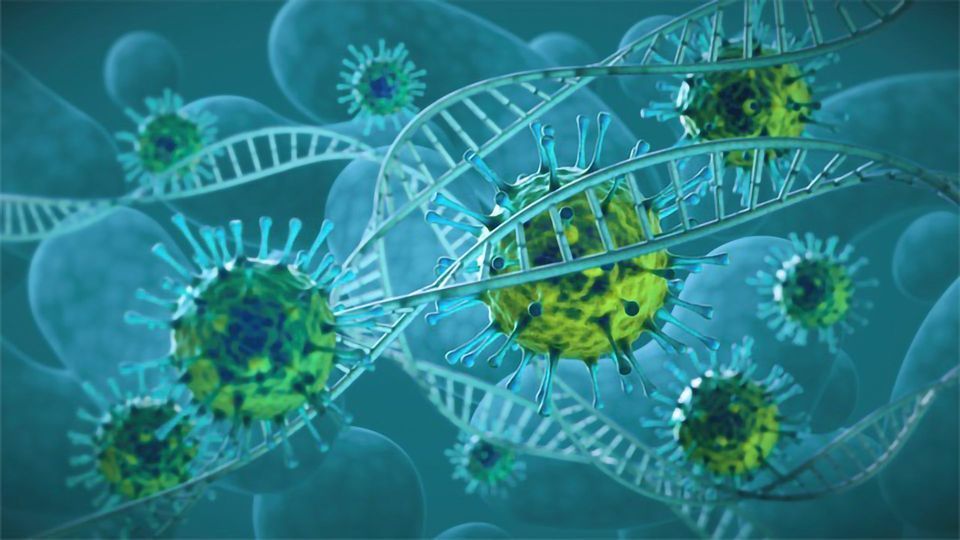4.1 – THE GENETICS OF VIRUSES
| 10 Students |
| Grade 11-12 |
COURSE DESCRIPTION
The nuclear genomes of eukaryotes differ greatly in size, number of genes and density from one another. The number of chromosomes differs between species and, in addition, certain organelles in eukaryotes possess small amounts of their own DNA. Eukaryotic genomes generally have a higher proportion of non-coding DNA to coding DNA. In addition to a large, circular chromosome, bacteria also have several plasmids. Even though bacteria reproduce asexually, they exhibit a great deal of genetic diversity through mutation and genetic transfer. In contrast to eukaryotic and prokaryotic genomes, the viral genome varies according to the type of virus: the genome may be DNA or RNA in nature and single – or double-stranded. For RNA viruses, they may possess either positive-sense RNA (i.e. identical to viral mRNA and thus can be immediately translated) or negative-sense RNA (i.e. complementary to viral mRNA and thus must be converted to positive-sense RNA by RNA polymerase before translation).
LEARNING OUTCOMES
Candidates should be able to:
- Outline the cell theory with the understanding that cells are the smallest unit of life, all cells come from pre-existing cells and living organisms are composed of cells.
- Describe the structural components of viruses, including enveloped viruses and bacteriophages, and interpret drawings and photographs of them
- Discuss how viruses challenge the cell theory and concepts of what is considered living
- Describe the structure and organisation of viral, prokaryotic and eukaryotic genomes (including DNA/RNA, single/double-stranded, number of nucleotides, packing of DNA, linearity/circularity and presence/absence of introns)
- Describe how the genomes of viruses are inherited through outlining the reproductive cycles of:
- bacteriophages that reproduce via a lytic cycle only, including T4 phage
- bacteriophages that reproduce via lytic and lysogenic cycles, including lambda phage
- enveloped viruses, including influenza
- retroviruses, including HIV
- Describe how variation in viral genomes arises, including antigenic shift and antigenic drift
Use the knowledge gained in this topic in novel situation to solve related problems.
Lecture Outline
Overview of Topic
- What is a Virus?
- Viruses are Obligate Intracellular Parasites
- Are Viruses Living or Non-living Organisms?
- General Structure of Viruses
2.1 Structure and Organisation of Viral Genome
2.2 Capsid – present in ALL viruses
2.3 Envelope – present in ENVELOPED VIRUSES only
2.4 Enzymes
- General Reproduction Cycles of Viruses
- Types of Viruses
4.1 Bacteriophages
4.1.1 T4 Phage – A Virulent Phage
Reproductive Cycle – The LYTIC CYCLE
4.1.2 Lambda phage – A Temperate Phage
Reproductive Cycle – The LYSOGENIC CYCLE
Concept Check
4.2 Enveloped Animal Viruses
4.2.1 Influenza Virus
Reproductive Cycle for Influenza Virus
4.2.2 Human Immunodeficiency Virus (HIV)
Reproductive Cycle for HIV
- Mechanisms for Variation in Viral Genomes
5.1 Overview of Antigenic Shift and Antigenic Drift
5.2 Mechanism of Antigenic Shift
5.3 Mechanism of Antigenic Drift
5.4 Effect of Antigenic Shift and Drift
Requirements
- Donec porta ultricies urna, faucibus magna dapibus.
- Etiam varius tortor ut ligula facilisis varius in a leo.
- Folutpat tempor tur duis mattis dapibus, felis amet.
- Donec porta ultricies urna, faucibus magna dapibus.
- Etiam varius tortor ut ligula facilisis varius in a leo.
- Folutpat tempor tur duis mattis dapibus, felis amet.
What is the target audience?
- This course is intended for anyone interested in learning to master his or her own body.
- This course is aimed at beginners, so no previous experience with hand balancing skillts is necessary
Aenean viverra tincidunt nibh, in imperdiet nunc. Suspendisse eu ante pretium, consectetur leo at, congue quam. Nullam hendrerit porta ante vitae tristique. Vestibulum ante ipsum primis in faucibus orci luctus et ultrices posuere cubilia Curae; Vestibulum ligula libero, feugiat faucibus mattis eget, pulvinar et ligula.
CURRICULUM
Section 1: Introduction to Handstands
Section 2: Reference Material, Moodboards and Mind Mapping
Wrist Strengthening
While your wrists will certain get stronger from practice and grow accustomed to the stress of the skill, a basic amount of wrist strengthening exercises for several weeks can only help things. I’d recommend working wrist curls and reverse wrist curls for around 6-10 reps for 3 sets. I also strongly recommend trying some sledgehammer levering. Work in 2-3 sets of 3-5 reps. In particular, exercises 1 and 3 are fantastic for building wrist strength and they are much harder than they look! Start with them to get the hang of sledgehammer work before you progress to the other two exercises. I don’t want somebody putting a hole through their floor or their face because they rushed things!Section 3: Sketching out Ideas
- The main objective to the sketching process is to generate super rough thumbnail sketches of what we feel best visually communicates the highlighted words from our mind maps.
- Take as much time as you need for this step — this might be 10 minutes or it might be 10 days.
- Personally, I like to work quickly and try not to analyze or elaborate too much.
- Now, that doesn't mean you should only create a handful of sketches.
- Even though this step only took a couple of hours, I was still able to put over 100 thumbnails on paper.
- The whole point of this process is to flush out the bad ideas and narrow down the good ones until we find that one layout that really speaks to us.
- Also, keep in mind the project brief and have your list in front of you as a reference to avoid getting sidetracked.
- Remember—detail is not needed. Simply flush out the bad ideas and find a great direction.
- Once I feel I have a good direction with the sketches, I'm now ready to take a quick photo with my phone and import it into Illustrator.
Section 4: Conclusions and Evaluation
About Instructors
Reviews
Average Rating
Detailed Rating
| Stars 5 |
|
0 |
| Stars 4 |
|
0 |
| Stars 3 |
|
0 |
| Stars 2 |
|
0 |
| Stars 1 |
|
0 |
Be the first to review “4.1 – THE GENETICS OF VIRUSES” Cancel reply
| 10 Students |
| Grade 11-12 |



There are no reviews yet.